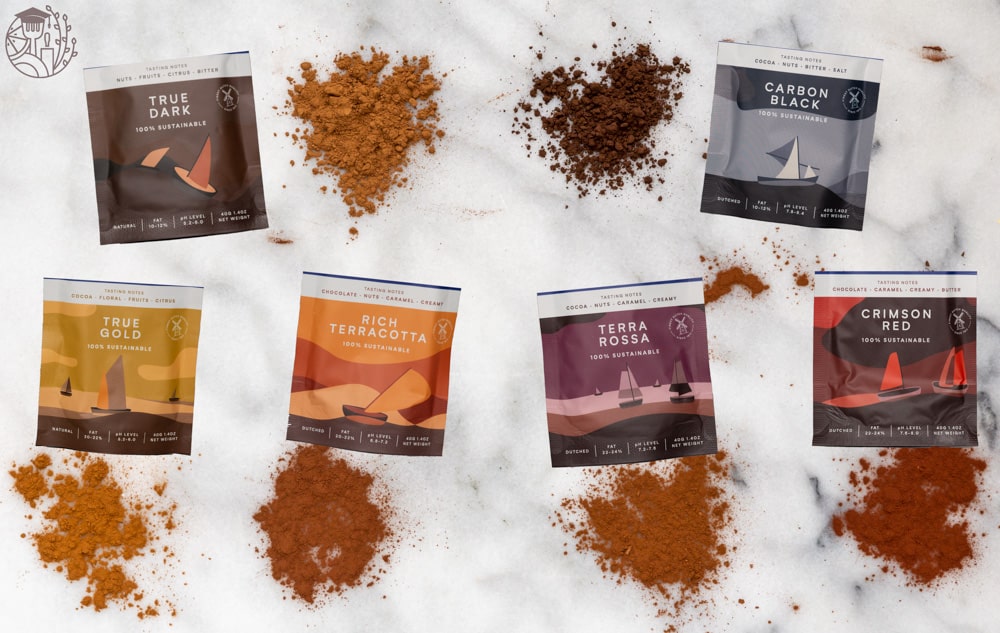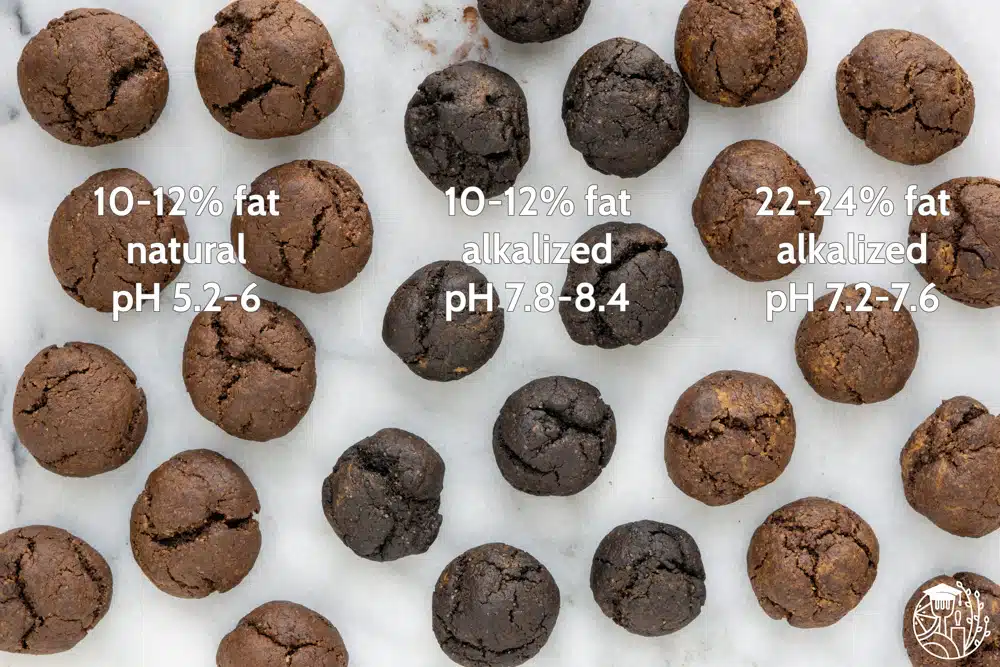Learn the science behind:

How to Choose Between Cocoa Powders
Have you ever experienced making a trusted chocolate cookie or cake recipe that somehow tasted different? Despite having made it the exact same way, several times before. Did you by any chance switch out cocoa powders? If so, that will have probably been the culprit!
You may think all cocoa powders are alike, like any other staple ingredient. But, that’s definitely not the case. There’s quite some variation within the world of cocoa powders, depending just exactly on how they’ve been processed. The fat content, whether or not the powder has been alkalized, and more, all impact the functionality and flavor of cocoa powders.
Are all cocoa powders the same?
Short answer: no. There is a huge variation within the world of cocoa powders. As a consumer, you’ll have the choice between several types. As a professional, however, your range of options becomes even bigger! To properly understand these possible differences, we’ll need to have a look at the origin story of cocoa powder and looks at how it comes to be.
Cocoa powder is made from cocoa beans
Cocoa powder starts out as a cocoa bean, inside a cocoa pod. After harvest, the cocoa beans are fermented and dried. Once dry, a cocoa bean can be stored and transported all around the world. Next, the dried beans are cleaned, broken and separated into smaller pieces (nibs), and roasted. The roasted nibs are then pressed to remove (part of) the fat and get a dry cocoa powder. Some cocoa powders may also be alkalized. All of these individual steps can influence just how your cocoa powder turns out but some have a bigger impact than others, we’ll focus on two:
- Alkalized vs. natural cocoa powders
- Fat content

Alkalized vs natural cocoa powders
Cocoa powder is naturally slightly acidic due to the acids that are formed during fermentation and further process steps. Manufacturers found that by adding an alkaline ingredient, which is the opposite of an acid, they could they the properties of the cocoa powder. For instance, it can make darker color cocoa powders. Alkalization enables the production of pitch-black Oreo cookies for instance.
Cocoa powders that have not been alkalized are referred to as ‘natural’. Those that have been alkalized may be called Dutch, Dutch-processed or alkalized powders. Terminology does differ around the world and not everywhere is this distinction made clearly on the packaging.
These powders can be referred to as ‘Dutch’ because the inventor, van Houten, was Dutch. He lived in the Netherlands.
Alkalization turns cocoa darker
Dutch-processed cocoa powder is darker in color than natural powder. During alkalization heat and pressure are used to alkalize the cocoa. This in turn impacts the Maillard reaction which is a crucial chemical reaction for color formation in food.
Baking soda needs acidic cocoa
If your product uses baking soda for leavening purposes, it’s important to keep in mind the possible role of cocoa powders. Baking soda will only leaven a product if an acid is present. This could be buttermilk, vinegar, or lemon juice for instance, but it might also be cocoa powder. Alkalized cocoa powders are no longer acidic, so if used for this purpose, choose a natural cocoa powder.
Alkalization improves solubility
During the alkalization process, certain chemical processes take place that help disperse cocoa powders in water, or liquids such as milk. It is why most chocolate milk mixes use alkalized powders, these can be mixed in more easily.

Fat content
Cocoa beans naturally contain a high amount of fat, about 50%. This fat is also referred to as cocoa butter and is crucial for a lot of typical chocolate characteristics. For instance, it’s the reason chocolate needs to be tempered. Cocoa butter is a very valuable ingredient and as such, greatly impacts the price of a cocoa powder. Fat content for cocoa powders can differ widely. Some, especially cheaper powders, barely contain any, others contain up to 25% fat. More fat makes the powder itself more prone to stickiness and clumping.
If a recipe uses a significant amount of cocoa powder, the fat content of the powder may impact the final product. It may result in too much, or too little fat. The labels will always mention the fat content of cocoa powder, if not explicitely, it’s mentioned in the nutritional value section. Even though cocoa powders with a higher fat content will be more expensive, that does not necessarily mean their cocoa flavor is different from that of other powders. It simply contains more fat. Whether that’s desirable, depends on your final application.
Other (minor) differences
The origin of the beans, the way they’ve been fermented and roasted, it all impacts the color and flavor of the final powder. However, generally speaking, you won’t have a choice for specific types of roasts or origins of cocoa powders. Often, manufacturers blend different varieties together to help ensure a consistent, even flavor profile over time.
Sweetened vs unsweetened
Cocoa powder is bitter, unlike chocolate. This is because chocolate contains added sugars for sweetness. Pure plain cocoa powder will always be unsweetened. Some manufacturers may add sugar and call it sweetened cocoa powder. This is especially common for powders used for making chocolate milk. Most people would expect chocolate milk to be sweetened, so manufacturers have added it on forehand. For optimal control of sweetness though, it’s best to use unsweetened cocoa powders in things like baked goods.
Choosing cocoa powders
The actual most suited cocoa powder will depend on what you’re using it for. Keep in mind that for small scale applications, the most important factor is almost always taste. Some cocoa powders clearly taste very different than others.
Cookies: differences are minor
To test some of the hypothesis we discussed here, we baked cookies with about 7% cocoa powder, using 3 different types of cocoa powder. These cookies contained baking soda and no other acid. However, despite the stark differences between powders, the differences between the cookies themselves were minor! Yes, the color of one was clearly darker than the others. But, they’d all expanded similarly and tastewise were very similar as well. It could well be that the differences are more pronounced if we’d made 1000 cookies each, but for our small scale, the differences are negligible.

Chocolate milk: differences are minor
The same happened when making chocolate milk from both a natural and (heavily) alkalized powder. We’d expected the alkalized one to work better since it’s supposed to disperse more easily. However, the differences were minor, except for the color. Of course, making chocolate milk at small scale is quite different to doing so at a large scale. It’s easy to mix a small amount of milk and powder, but it can be harder to do so for bigger quantities.
Use your taste buds
In the end, and especially at smaller scales, it’s all about taste. For instance, we tested three common brands of cocoa powder in the Netherlands: Blooker, Droste and Kruger. We absolutely did not like how Kruger tasted in cookies and cakes and liked both others. The label doesn’t clearly specify the difference, but I suspect the Kruger cocoa powder was (way) more alkalized which resulted in a different flavor. It was also the darkest in color. All three made cookies and cakes that looked and performed good, we simply liked one more than the other.
So, if in doubt, choose the one that tastes best. Once you’re looking at making larger quantities, keep in mind that considerations on suspendibility, acidity, etc. because they’ll only become more important at scale!
Sources
E.O. Afoakwa, Cocoa production and processing technology, 2014, chapter 12, link
Parks, S., 4 Natural Cocoa Powders That Put the Supermarket Stuff to Shame, 2018, link
Valverde-Garcia, D.; Pérez-Esteve, É.; Barat Baviera, JM. (2020). Changes in cocoa
properties induced by the alkalization process: A review. Comprehensive Reviews in Food
Science and Food Safety. 19(4):2200-2221. https://doi.org/10.1111/1541-4337.12581
What's your challenge?
Struggling with your food product or production process? Not sure where to start and what to do? Or are you struggling to find and maintain the right expertise and knowledge in your food business?
That's where I might be able to help. Fill out a quick form to request a 30 minute discovery call so we can discuss your challenges. By the end, you'll know if, and how I might be able to help.





Beautiful am going to try it